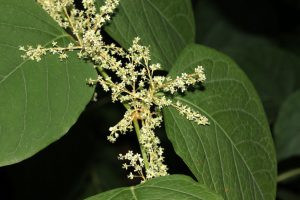Named for its cream-coloured flowers, Japanese Knotweed has become a pest and plague and requires effort and consistency to remove. Here is what you need to know.

STEP 1: Identify the Japanese knotweed.
Before you begin yanking weeds and pouring out the weed killer — or summoning the help of a professional— you will want to make sure what you are facing is indeed Japanese Knotweed. This is a much more complex problem than your regular weeds and Googling “dealing with garden weeds” will do you no good here.
Japanese Knotweed is a perennial plant and this means that it will sprout in the spring and die each winter. Knotweed prefers sunny spots with plenty of moisture to support its growth, riverbanks, well-watered gardens and lawns and other empty lots make the perfect home for this invasive species of plant that can grow as high as ten feet with roots up to 20 feet.
STEP 2: Determine the best method for the time of year.
Different methods of eradicating the menace will prove more effective at different times of the year. As an aggressive expansionist, regular pruning, sheering, and excavating will be imperative to minimize the growth of these weeds.
For best results, it is recommended that you employ more than one method of attack to improve the efficacy of your efforts. If you are unsure of how this is to be done or lack the time and skill to handle this task effectively, call in a professional to help. Knotweed Specialists UK is an excellent provider of Japanese knotweed removal in Hampshire.
STEP 3: Smother knotweed in the spring.
Spring is the beginning of the Knotweed season and you will need to get to work right away. Begin by smothering the young shoots with a heavy tarp weighted down by heavy rocks. Cut all taller stems that have already emerged to ground level before you begin and remove all obstacles in the area. Once the obstacles have been removed and all stems cut down as low as you can, lay out tarps on the entire area. If you have to use more than one tarp, be sure to overlap the edges so that no tough stems receive light and oxygen to grow again.
Hold the tarps in their place with cinder blocks, heavy rocks, or some other heavy object. If the wind were to blow the tarp over the practice would be futile. You may even notice that some shoots continue to grow beneath. Walk around on the tarps to crush the tender shoots below and ensure complete eradication.
Leave the tarps as they are for weeks or months, or until a landscaping expert informs you that it is safe to remove the tarps. Smothering is one of the surest ways to beat back the Knotweed menace, but because it can take an especially long time, it is probably best that you combine this method with other eradication methods to get the task done quickly.
STEP 4: Cut down Japanese knotweed during the summer.
Unfortunately, Knotweed can only be suppressed, not fully eradicated, by cutting back the plant. So, you must apply other methods of eradication as well.
Cut the plant’s stems down to the ground level, this will prevent the plant from reaching the sunlight needed for photosynthesis. Then be sure to gather the shoots and leaves and all bits of the plant. Only a small bit of stem is needed to grow a new plant, so collect all the debris and place it in a dark plastic bag. Keep an eye on your garden and take action if any new shoots rear their head.